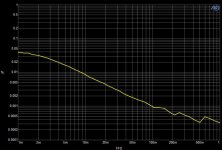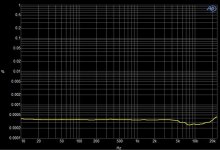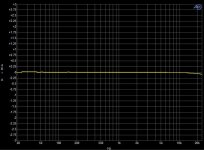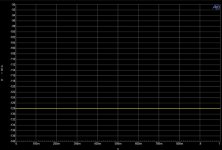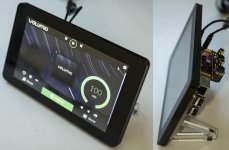Whats the benefit of having 135dB DNR (dynamic range) if SNR (signal-noise-ratio) is "just" 128dB? Makes no sense to me.
I also wonder how you achieve 135dB DNR when the 1794A datasheet specs 132dB at best. Are all these specs from measured values? If yes, the measurement system is from great interest.
I also wonder how you achieve 135dB DNR when the 1794A datasheet specs 132dB at best. Are all these specs from measured values? If yes, the measurement system is from great interest.
Last edited:
Looks to me that the 135dB DNR claim rests on a mis-interpretation of an FFT. Look here : ApplePi DAC - Highest Performance Rpi DAC Launched - DAC - Digital to Analog Conversion - Computer Audiophile
Eyeballing that plot seems to me to show a bin width around 30Hz - look at the width of the flat lines at the LF end.
Eyeballing that plot seems to me to show a bin width around 30Hz - look at the width of the flat lines at the LF end.
Without the Kickstarter hype tell us more about why this is so good. Why the choice of DAC ChipSet? What special technical attributes does it have (and please, frequency response and THD tell us nothing). It seems quite expensive for what I see on the pcb.
The reasoning behind using the PCM1794 is the DAC DAC.
I am the designer of that DAC and the ApplePi DAC uses the same output circuits. Compare the price $1200 vs 175.
The DAC DAC sounds absolutely amazing. I wanted to reproduce the same sound for the Pi.
I recommend you to sign up for the ApplePi DAC tour here:
Introducing ApplePi DAC -- Highest Performance Raspberry Pi DAC
Once you hear it, I believe you will appreciate it.
Here are quotes from two of the people that participated in the tour so far:
"I highly suggest that folks sign up for the tour to hear this wonderful device.
I spent a good week listening to it and came away extremely impressed with what Leo has done with this DAC hat.
For anyone that is using a Squeezebox Touch or similar unit, they should find this to be an quite an upgrade.
I did compare it to a DAC I built with AK4990 DAC chip and Salas shunt regulators DIY modular DAC
I really could not pick one over the other. The sonic difference was completely dependent on the file being played. I feel both units are very transparent.
For under $250, the combination of a Rpi and the ApplePi DAC board is an outright bargain in today's audio world.
When it is released, I will be buying one."
and
"I have had the Apple Pie for a while and I must say I am really impressed.
I am also impressed with Leo or Orchard Audio. I had some issues with the Ethernet connection that we finally figured has to be my Comcast router. He spent almost two hours on the phone with me.
As all our work failed Leo packed up a Smarti Pi Touch with his DAC board. While this isn't the current tour setup I would hope that it is explored. This configuration would allow the listener to view the current play information with out a smart device. I personally like the set up as I have been hitting random on my music catalog. And it seems I do a lot more of "What is That".
Any way this is a dammed fine budget setup that punches way above it's weight.
I have had a couple friend over and they share my assessment.
I look forward to the finished product.
Alan."
"I highly suggest that folks sign up for the tour to hear this wonderful device.
I spent a good week listening to it and came away extremely impressed with what Leo has done with this DAC hat.
For anyone that is using a Squeezebox Touch or similar unit, they should find this to be an quite an upgrade.
I did compare it to a DAC I built with AK4990 DAC chip and Salas shunt regulators DIY modular DAC
I really could not pick one over the other. The sonic difference was completely dependent on the file being played. I feel both units are very transparent.
For under $250, the combination of a Rpi and the ApplePi DAC board is an outright bargain in today's audio world.
When it is released, I will be buying one."
and
"I have had the Apple Pie for a while and I must say I am really impressed.
I am also impressed with Leo or Orchard Audio. I had some issues with the Ethernet connection that we finally figured has to be my Comcast router. He spent almost two hours on the phone with me.
As all our work failed Leo packed up a Smarti Pi Touch with his DAC board. While this isn't the current tour setup I would hope that it is explored. This configuration would allow the listener to view the current play information with out a smart device. I personally like the set up as I have been hitting random on my music catalog. And it seems I do a lot more of "What is That".
Any way this is a dammed fine budget setup that punches way above it's weight.
I have had a couple friend over and they share my assessment.
I look forward to the finished product.
Alan."
Hi,
It looks like a very nice dac.
Is it able to play DSD Native or Dop?
If yes, which ones? 64/128/256?
Thank you for your answer
This DAC supports PCM up to 24-bit and 192kHz
The Raspberry Pi will automatically convert to one of the supported bitrates.
Last edited:
Looks to me that the 135dB DNR claim rests on a mis-interpretation of an FFT. Look here : ApplePi DAC - Highest Performance Rpi DAC Launched - DAC - Digital to Analog Conversion - Computer Audiophile
Eyeballing that plot seems to me to show a bin width around 30Hz - look at the width of the flat lines at the LF end.
I am sorry for any mis-information, I have reviewed all of the measurement data that I have received and I do not know how the third party came up with a dynamic range of 135dB.
In the future I will have to review all data more carefully.
All other measurements are correct.
See attached plots.
1. THD+N vs amplitude
2. THD+N vs frequency (0dBFS 1kHz)
3. Frequncy Response (0dBFS 1kHz)
4. SNR
Attachments
Last edited:
This DAC supports PCM up to 24-bit and 192kHz
The Raspberry Pi will automatically convert to one of the supported bitrates.
ok.
thanx
Looks to me that the 135dB DNR claim rests on a mis-interpretation of an FFT. Look here : ApplePi DAC - Highest Performance Rpi DAC Launched - DAC - Digital to Analog Conversion - Computer Audiophile
Eyeballing that plot seems to me to show a bin width around 30Hz - look at the width of the flat lines at the LF end.
Thanks mate.
@orchadaudio
Thanks for clarification.
Now you can get and ApplePi DAC system that is completely ready to go out of the box, and includes a 7" touchscreen.
Here is a video showing it in action:
ApplePi DAC System w/ 7" Touchscreen
Kickstarter project link:
ApplePi DAC - Highest Performance Raspberry Pi DAC by Leonid (Leo) Ayzenshtat —Kickstarter
Here is a video showing it in action:
ApplePi DAC System w/ 7" Touchscreen
Kickstarter project link:
ApplePi DAC - Highest Performance Raspberry Pi DAC by Leonid (Leo) Ayzenshtat —Kickstarter
Attachments
Last edited:
The Kickstarter project is now fully funded.
Get your ApplePi DAC product at a discount.
ApplePi DAC - Highest Performance Raspberry Pi DAC by Leonid (Leo) Ayzenshtat —Kickstarter
Get your ApplePi DAC product at a discount.
ApplePi DAC - Highest Performance Raspberry Pi DAC by Leonid (Leo) Ayzenshtat —Kickstarter
...the actual question is: Will it sound ANY better than a 40 EUR IQAudIODAC (for example). Why would there be any noticeable differences?
It will sound much better based on all of the feedback that I have received from reviewers and people who have been on the tour.
Every person from the tour who has listened to the device bought one through kickstarter. To me that says something.
You can learn more about the tour and sign up if you want here:
Introducing ApplePi DAC -- Highest Performance Raspberry Pi DAC
The tour will continue beyond kickstarter.
It will sound much better based on all of the feedback that I have received from reviewers and people who have been on the tour.
I'll reformulate: Given that even 30-50 EUR RPI I2S devices are completely transparent and distortion-free by any means and purposes, what are the factors causing such an obvious and audible difference? We're talking incredibly small differences in specifications here, where no human being can possibly sense a difference.
The fact that the user hearing it are buying it doesn't surprise me, as it probably sounds really good, but it's not relevant for this question.
I'll reformulate: Given that even 30-50 EUR RPI I2S devices are completely transparent and distortion-free by any means and purposes, what are the factors causing such an obvious and audible difference? We're talking incredibly small differences in specifications here, where no human being can possibly sense a difference.
The fact that the user hearing it are buying it doesn't surprise me, as it probably sounds really good, but it's not relevant for this question.
Outside of SNR, frequency response and THD, there is a myriad of other electrical factors:
- Phase shift
- Drive capability
- Output impedance
- Transient response
- Intermodulation distortion
- Slew rate
- The list can go on.
These other factors influence how a device will sound. So two devices with the same THD and SNR will not necessarily sound the same.
By using high quality proven devices; dual PCM1794A and 6 x OPA1612 opamps for the analog portion of the design, I am not only achieving great specs but a great sound as well.
Last edited:
Thank you for the quick replies. I would be interested in testing one, and compare it with other HAT systems I have, is that possible?
It is possible, please sign up for the tour:
Introducing ApplePi DAC -- Highest Performance Raspberry Pi DAC
- Status
- This old topic is closed. If you want to reopen this topic, contact a moderator using the "Report Post" button.
- Home
- Vendor's Bazaar
- ApplePi DAC -- Highest Performance Raspberry Pi DAC
